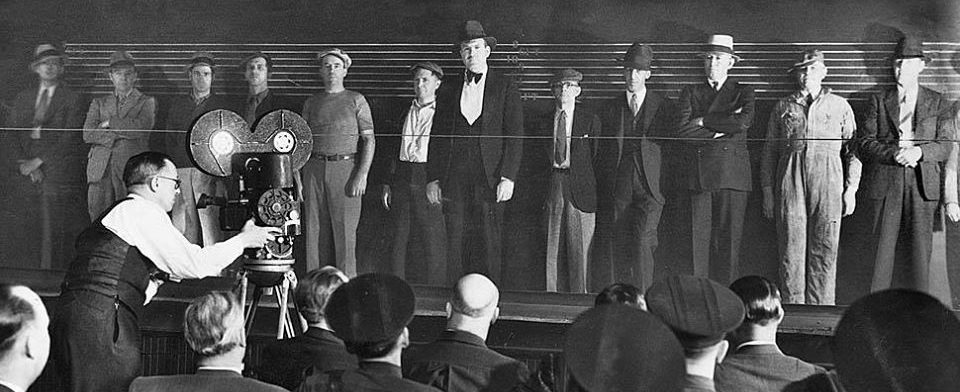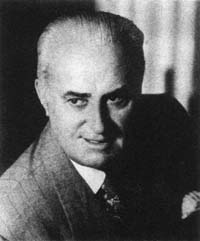Simon’s hamburger stand at the SE corner of Sunset Boulevard and Highland Avenue opened in early 1939, one in a small chain of locally-owned drive-in cafes started in 1935. It was the second Simon’s on Sunset Boulevard- the first was at 8801 Sunset on the Strip- but this location across the street from Hollywood High School was an instant hit.
A permit for this location was granted by the City in December 1938. The architect/engineer on record is S.B. Barnes.
The Simons were brothers William Harold Simon and performer-turned-restaurateur Mike Lyman, who were partners in a string of eateries and nightclubs along with their other brothers Albert Simon and bandleader-songwriter Abe Lyman and others.
Michael “Mike” Lyman was born Issac Simon in Chicago in 1887 to Fannie and Jacob Simon, who had come to the USA from Europe in 1885. In 1910, as Michael Simon, he was working as an actor/singer in a cafe in his native Chicago. By 1916 he’d changed his name to Mike Lyman and was living in Los Angeles, a singer at Baron Long’s Sunset Inn in Santa Monica and Long’s Vernon Club.
No one ever called Baron Long a gangster. He masqueraded as a respectable citizen. He was closely affiliated with Spring Street gangsters like Charles Crawford, Farmer Page, Zeke Caress, Tutor Scherer and his joints, run by fronts, were notorious for liquor violations, gambling and other illicit activities.
In November 1917 the City of Los Angeles passed the Gandier Ordinance, which banned the sale of strong liquor, effectively closing saloons within the city limits. Outlying communities like Vernon, Venice, Santa Monica and other beach towns, attracted the patrons looking to skirt the law. In addition to the Vernon Club, Baron Long operated the Ship Cafe in Venice and the Sunset Inn in Santa Monica. Mike Lyman performed at all three.

In 1918, Long turned the Sunset Inn over to the Red Cross. It was open as a cafe only on certain nights. LA Times 7/7/1918
By late 1919, Mike’s younger brother Abraham (“Abe”), who also adopted the stage name Lyman, had come out to Los Angeles and was appearing at Baron Long’s Vernon Club.
In 1920, Mike was in charge of entertainment at the reopened Sunset Inn, while Adolph “Eddie” Brandstatter, lately maitre’d of the Victor Hugo restaurant downtown, ran the hospitality side of things. National Prohibition was now the law of the land.

Mike Lyman in charge of “diversions” at the Sunset Inn after its reopening in 1920. Eddie Brandstatter ran the hospitality side of the business. LA Evening Express 6/21/1920
Abe Lyman, having formed his own orchestra, was soon in demand as the house band at the Ambassador Hotel’s Coconut Grove nightclub, and as a songwriter and recording artist.
Mike Lyman, meanwhile, moved away from performing and was running cafes and nightspots full time with brothers William H. “Big Bill” Simon (born in Chicago in 1896 and known as Harry as a child) and Albert (born in Chicago in 1889 as Alexander Simon) and others. In December 1920 they formed the Winter Garden Corporation, taking over a longtime Los Angeles cafe, McKee’s, at 520 South Spring Street upon the retirement of proprietor Sam McKee. The new Winter Garden cafe, addressed as 518 S. Spring, opened in February 1921.
In December 1921, Mike Lyman was managing the newly opened Palais Royal club at 616 S. Hill Street with his former partner V.B. “Blondy” Clark. The venture was short lived.
In May 1922 the Lyman/Simon syndicate purchased land on Washington Boulevard in Culver City for another new nightclub, the southern-themed Plantation Club. It opened in June 1922.

Announcing Mike Lyman’s purchase of land for the Plantation Club, Culver City along with his old partner V.B. “Blondy” Clark. LA Times 5/23/1922
The Winter Garden Corporation dissolved in August, 1923 and the cafe closed as did the syndicate’s Sunset Inn. The Sunset Inn would reopen that year in Tijuana, where Baron Long operated the turf club. Mike Lyman reopened 518/520 S. Spring as The States restaurant.
In October 1923, Mike Lyman also opened The Rendezvous at 616 S. Hill Street. It too was short-lived.

Ad for The Rendezvous, October 1923 “under the personal management of Mike Lyman.” Note “Fanchon’s Fancies.” Bill Simon married Fanchon of the brother and sister dance/choreographer duo Fanchon & Marco, who for a time would operate a dance school at 5600 Sunset.
In early 1925, the Lyman/Simon group began work on a dance hall/ballroom to be called the Palais de Dance at the same location in Hill Street of Lyman’s failed Palais Royal and the Rendezvous. A gala grand opening, with appearances by heavyweight champion Jack Dempsey and the Abe Lyman Orchestra, was planned for April 1925 but had to be postponed when the police commission would not issue a dance license due to an ongoing investigation into dance halls and cafes where dancing was allowed, for potential violation of the Prohibition laws. The opening was finally held in August 1925. But the venture was again short-lived.
In 1926, Mike Lyman opened the former McKee’s/Winter Garden/States location as the southern-themed Lymans’ Cafe Alabam, addressed as 520 S. Spring.
In 1927, Bill Simon, who had up until now been basically operating behind the scenes, opened the first of several Dairy Lunch cafes, which would bear the name Simon. Simon’s Dairy Lunch was located at 6630 Hollywood Boulevard in the new Cherokee Building.

Simon’s Dairy Lunch in the new Cherokee Building at 6630 Hollywood Boulevard, early 1928. This location operated into the 1940s. California State Library photo.
Other Simon’s Dairy Lunch spots opened in downtown Los Angeles. In May 1930, Bill Simon leased the former company dining room of the Pacific Mutual Building at Sixth and Olive streets for a large Dairy Lunch location.
The early 1930s were a difficult time for any business. Many failed. The Lyman/Simon brothers not only survived but steadily thrived with the dairy lunch counters. The repeal of national Prohibition in 1933 gave a boost to the restaurant industry, as cafes could now legally serve alcohol. Glamorous cocktail lounges were built or added to existing establishments to create an atmosphere of sophisticated tippling.
On April 23, 1935, Mike Lyman opened his first namesake cocktail lounge and grill at 751 S. Hill Street, location of the former Herbert’s Cafeteria.

1937 ad for Mike Lyman’s first Grill and Cocktail Lounge, 751 S. Hill St., featuring Frank Fay- who would go on to have his own namesake nightspot in the Valley.
Lyman would open a second Lyman’s Grill in Hollywood, in the former Al Levy’s Tavern at 1623 N. Vine Street in November 1941. Levy, like Sam McKee, was a pioneer restaurant owner. He’d opened the Vine Street location in 1930 and ran it until his death in May 1941. A fire swept through the night spot in July 1941, and in September 1941, the Simon/Lyman brothers leased and renovated the space.
After Bernstein’s Fish Grotto at 424 W. Sixth St. closed in April 1942, this location became the new Mike Lyman’s downtown grill.
In 1949, Simon’s Sunset and Highland Drive-In was used as a filming location for the gambling expose, 711 Ocean Drive. In the still below, Hollywood High School can be seen across the street.
In December 1951, the brothers sold 12 of their Simon’s drive-in restaurants and 5 of their cocktail lounges to Stanley Burke, Sacramento drive-in owner. This Simon’s is one of the 12 that became a “Stan’s.”

The Simon/Lyman brothers sale of 12 drive-ins and 5 cocktail lounges. Hollywood Citizen News 12/10/1951

As Stan’s. This photo is from USC, per this website (USC link is now broken)
Mike Lyman died in November 1952. Albert Simon died in December 1956. Abe Lyman died in October 1957.
Mike Lyman’s Hollywood grill continued to operate until April 1959 when Bill Simon decided the time had come to close it. The building was demolished in 1966. Lyman’s namesake bar and grill on West Sixth St. continued to operate until December 1965, when the fixtures were sold at auction and the building subsequently demolished. The former Simon’s/Stan’s drive-in at Sunset and Highland was demolished in 1971.
Bill Simon died in April 1976.
***
Notes
The Simon brothers also had two sisters: Sarah and Dorothy. Dorothy used the name Lyman for a time.


























